Russian revolvers
For the first time in Russia, at high level, the issue of replacing revolvers with smooth-bore pistols at that time was raised shortly after the end of the Crimean War 1853 – 1856, during which the Russian army was lagging behind in almost all types of small arms from the armies of other European countries. In 1859, at the request of the Minister of War, D. A. Milyukov, the Arms Committee of the Artillery Committee of the Main Artillery Directorate began a comparative test of the latest foreign-made revolvers.
The best was recognized by the French revolver Lefoche (Lefaucheux) M 1853. The commission noted a higher practical rate of fire of revolvers compared to single-shot pistols, their increased reliability and constant readiness for firing.
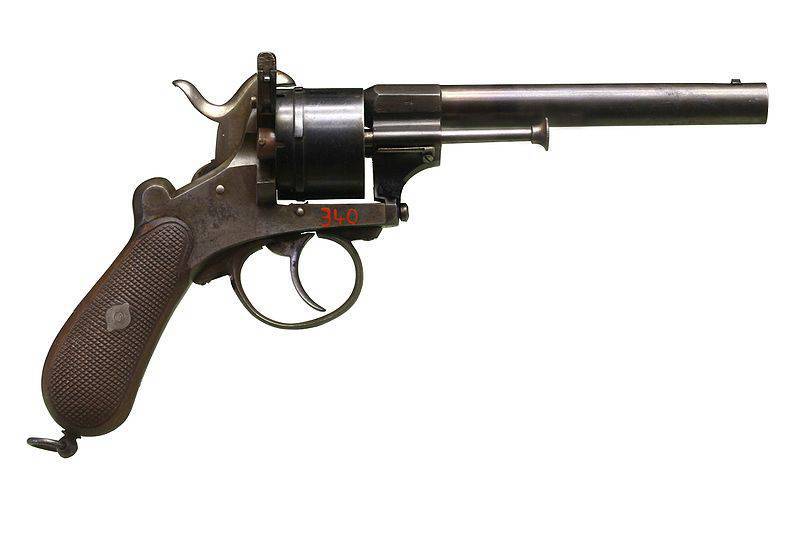
However, when it came to adopting revolvers, it turned out that the state does not have the necessary financial resources for this. For this reason, army and guard officers were asked to purchase these revolvers at their own expense. An exception was made only for the corps of gendarmes: 7100 of such revolvers were purchased for it.
It should be noted that the gentlemen officers were in no hurry to part with the usual pistols, while the Armory Commission, meanwhile, was closely following all the new models of revolvers appearing in the arms markets of Europe and America. At the end of 1860's the attention of the commission attracted a revolver. 44 American First Model of the American firm "Smith-Wesson» (Smith and Wesson). In the United States, this revolver was considered the best example of a short-barreled personal defense weapon. He was distinguished by the presence of an automatic extractor, high precision combat and a fairly powerful ammunition. It is therefore not surprising that the Armory Commission recognized the revolver quite suitable for adoption by the Russian army. In 1871, the necessary financial resources were sought for the purchase of 20 000 revolvers. 44 American First Model, which received the designation “4,2 linear revolver Smith-Wesson 1 sample” in the Russian army.
In the revolvers of the next batch, produced in 1872 – 1874, at the request of specialists of the Russian army, some changes were made concerning the design of both the revolver and its chamber. The revolvers of this party had the American designation No. 3 Russian First Model. From 25 179 such revolvers 20 014 units were sent to Russia.
Modernization of a revolver in the USA No. 3 Russian First Model led to the creation of an improved 2 model revolver (No. 3 Russian Second Model), and in 1880, the Russian army received an 3 model revolver with a shorter barrel and an automatic extractor that was turned off.
Smith-Wesson supplied Russia with 131 000 revolvers of three samples, but an even larger number was manufactured in Russia itself. In 1885, the licensed production of an 3 revolver was launched at the Imperial Tula Arms Plant, which lasted until 1889. Over the years, around 200 000 revolvers were produced. Another 100 000 units were manufactured for the Russian army by the German company Ludwig Leve and Co. (Ludwig Loewe und K °).
In total, the Russian army received a little more than 470 000 Smith-Wesson revolvers of various types, but they did not long remain the main model of army short-barreled weapons. The fact is that cartridges equipped with smoky powder used in these revolvers with a shell-less bullet did not provide as high ballistic qualities as cartridges with smokeless powder developed at the end of the 1880-s. In addition, with the adoption by the Russian army 3-linear rifle arr. 1891 in the Ministry of War came to the decision to unify the officers' personal weapons with it in caliber.
Since in Russia there were no sufficiently advanced developments in this area, at the beginning of the 1890s. tests of new revolvers developed by foreign companies in accordance with the tactical and technical requirements of the Russian Military Ministry were conducted. It is noteworthy that these requirements eliminated the presence in the revolver of an automatic extractor of spent cartridges and a self-driving mechanism that allows firing without manually triggering the trigger, but only by pressing the trigger.
Thus, the practical rate of fire was deliberately reduced and the fighting qualities of weapons deteriorated, but for the Military Ministry it was more important to reduce the cost of manufacturing revolvers and save ammunition.
According to the results of testing various types of revolvers, preference was given to two Belgian revolvers designed by Henry Pieper and Leo Nagant. Modified in accordance with the remarks of the Russian military, the models of revolvers of these designers were tested in 1893 – 1894. Pieper's revolver was rejected because of low-power cartridges, the bullets of which in some cases did not pierce one pine plank as thick as 1 inch (25,4 mm). The bullet of the revolver of the Nagan system pierced five such boards, its design met all the requirements of the Ministry of War.
13 in May 1895. Emperor Nicholas II signed a decree accepting this revolver into service with the Russian army under the title “3-linear revolver of the Nagan system arr. 1895.
The contract for the production of the first batch in 20 000 revolvers was issued to the Belgian company Manufacture d´Armes Nagant Freres in 1895. The contract stipulated that this company also provide technical assistance in the deployment of the production of revolvers mod. 1895, at the Tula Arms Plant.
The first revolvers of Tula production appeared in 1898. In total, before the start of the First World War, the Russian army received an 424 434 revolver arr. 1895 g., And in the period from 1914 to 1917 g. - 474 800 units. In 1918 – 1920 Tula Arms Factory also manufactured 175 115 revolvers.
During the Civil War revolvers arr. 1895 was in service with both the White and Red armies. In the Red Army, the revolver remained the only regular model of short-barreled weapons up to 1931, when the first thousand TT pistols were made. Although the TT was adopted by the Red Army instead of a revolver arr. 1895 g., Due to a number of objective and subjective reasons, both systems were produced in parallel up to 1945 g., When the revolver finally lost its position to a more efficient and easy-to-use TT pistol. The revolvers removed from the armament of the Red Army were used for quite a long time in the police and private security units.
The “rebirth” of the revolver took place in the 1990s, when private security companies began to be created in the Russian Federation (the so-called legal entities with special statutory tasks), which were allowed to store and use short-and long-barreled firearms. Relatively easy to use, reliable and constantly ready to open fire, revolvers were recognized as the best type of service weapon. Already in 1994, the release of the revolver arr. 1895 was originally renewed at Izhevsk Mechanical Plant. New models of domestic revolvers were also created, in which the latest achievements in the field of both the designs of the weapon itself and its production technology are implemented.
In particular, in the AEK-906 “Rhinoceros” revolver of the Kovrovsky Mechanical Plant a new layout scheme was used with the location of the barrel and drum retainer in the lower part of the frame, and the drum axis above the barrel. This scheme allowed to create weapons with excellent balance and accuracy of fire. The balance is achieved by approaching the center of gravity of the revolver to the axis of the barrel and reducing the line of fire relative to the hand of the gunman, which reduces the recoil arm. This quality is especially valuable when maintaining a quick fire to kill, since when fired, toss the revolver upward decreases. This contributes to the rapid restoration of the position of the revolver for aiming and producing the next shot.
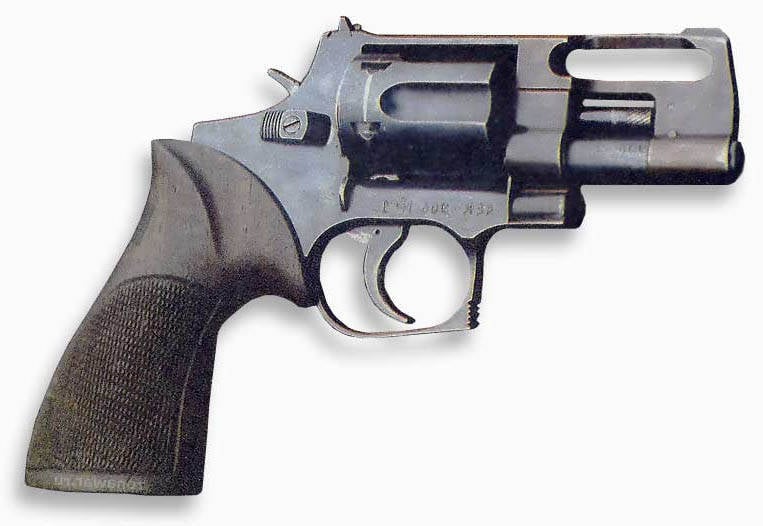
The layout of the P-92 revolver of the Tula Instrument Engineering Design Bureau (KBP) enterprise is also unusual. It is sometimes called the “pistol” - in order to reduce the size of the weapon in order to ensure its concealed carrying, the drum unit and barrel are shifted towards the handle. Such a constructive solution allowed not only to reduce the length of the revolver, but also had a positive impact on the convenience of aiming and shooting from it, since the center of gravity was shifted to the hand of the shooter.
The design of the trigger mechanism of this revolver has its own characteristics. His trigger when pressed does not turn, but moves back, interacting with the trigger through the lever. This provides some improvement in shooting accuracy.
An interesting feature of some modern Russian revolvers is that they are designed for the 9 × 18 mm PM pistol cartridge. The fact is that in the Russian Federation huge mobilization stocks of such cartridges have been created, therefore the creation of a new weapon for this cartridge seemed quite a reasonable solution. The complexity of the development of revolvers for this cartridge is that its sleeve does not have a protruding rim, so you have to use special clips for fast loading. For example, such clips are created for revolvers AEK-906 "Rhino", OZ-01 "Cobalt" and P-92. However, the designers have provided the possibility of loading these revolvers without clips, but this requires much more time.
It should be noted that, along with pistol cartridges, other unusual ammunition is used in Russian revolvers.
Thus, the DOG-1 revolver of the Tinta promotional enterprise and the Izhevsk Technical University shoots cartridges based on the 12,5 × 35 mm rifle cartridge. A rather wide range of such cartridges has been developed: with lead or plastic bullets, lighting and signal light cartridges, a cartridge for sounding signals.
The OC-20 “Gnome” revolver ammunition of the TsKIB SOO enterprise includes powerful 12,5 × 40 mm cartridges equipped with a steel or lead bullet of 11 and 16 g, respectively. A steel bullet at a distance of 50 m punches through a steel sheet with a thickness of 3 mm, and the lead bullet has an extremely powerful stopping effect. There is also a cartridge equipped with 16 lead pellets. It reliably ensures the defeat of group goals.
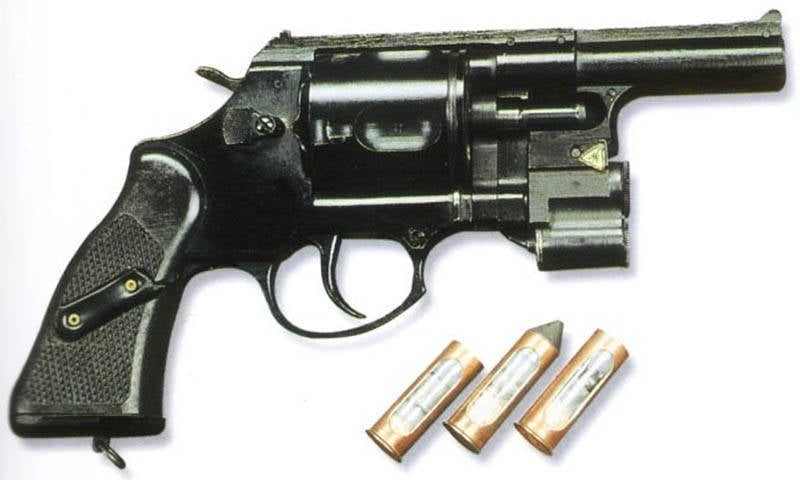
Perhaps the most unusual cartridge used in the revolver OTs-38, developed by the famous Russian gunsmith I.Ya. Stechkin for special forces units of the Ministry of Internal Affairs and the FSB. This is a special cartridge SP.4, flangeless sleeve which completely hides a cylindrical steel bullet and a special piston. When fired, the piston acts on the bullet up to its exit from the liner, but is fully wedged in the liner and does not extend further. As a result, the powder gases are locked in the sleeve, which ensures noiseless shots and the complete absence of flame. At the same time, as in all revolvers, the cartridge case remains in the drum, and is not extracted, as it happens when shooting from a self-loading pistol. This makes it difficult to identify weapons, which is important when conducting special operations.
Along with the creation of revolvers for various, sometimes exotic ammunition, Russian gunsmiths widely use new types of steel and light alloys in their developments. For example, the MP-411 “Latina” revolver of the Izhevsk Mechanical Plant is assembled on a light alloy frame. Work is also underway on the use of high-strength plastics.
Thus, it can be stated that Russian revolvers have a future.
At the end of the 19th century, the Russian army was armed with 4,2-linear (10,67 mm) Smith-Wesson revolvers of three samples. It was a very good for its time weapon of the turning scheme, which provided automatic extraction of spent cartridges from the drum when reloading. The disadvantages of these revolvers carried a large mass, non-self-firing firing mechanism, in which the shooter manually cocked the trigger before each shot, and, most importantly, the cartridges filled with black powder. The shellless bullet of such a cartridge at a distance of 25 m punched three pine boards with a thickness of 1 inch (25,4 mm), while for bullets of revolver cartridges with smokeless powder and five such boards were not the limit. However, the main reason that prompted the Russian Military Ministry to announce a competition for a new army revolver was the transfer of the Russian army to the caliber of small arms in the 3 line (7,62 mm). Under the cartridge of such a caliber in 1891, a rifle was adopted for use, it was logical to have an army and a revolver of the same caliber in the armament.
In order to hold an open competition for the new 7,62 mm revolver, the Ministry of War in 1892 published tactical and technical requirements, according to which “a military revolver must have such a battle so that a single bullet at a distance of 50 steps stops the horse. If a bullet pierces four or five inch boards, the strength of the fight is then sufficient. ” The revolver also had to have a mass of 0,82 – 0,90 kg, the initial bullet velocity required at least 300 m / s with good shooting accuracy.
It is noteworthy that in order to simplify the design and reduce the cost of manufacturing a revolver, it was necessary to abandon the automatic extraction of sleeves when reloading and not to use a self-driving trigger mechanism, since it “adversely affects accuracy”. The real reason for these requirements, which reduced the practical rate of fire of the revolver and the obviously knowingly putting Russian soldiers into worse conditions than other European armies, was the desire to reduce the consumption of ammunition.
According to the results of the competition, the non-self-propelled revolver of the Belgian gunsmith Leon Nagan was recognized as the best, but in the course of military tests conducted in cavalry and artillery officer schools, the opinion was expressed that the revolver should still be self-cocked, as was common in all European armies.
The decree on the adoption of a revolver into service with the Russian army was signed by Emperor Nicholas II 13 in May 1895. The officers' opinion was taken into account as follows: to release the revolver with the self-propelled trigger mechanism for the officers, and with the non-self-starter trigger mechanism for the lower officers who during a fight allegedly control their actions worse and tend to waste their ammunition.
Only the self-cocked version of the revolver was adopted by the Red Army.
In the design of the revolver, a very successful combination of high firepower with sufficient accuracy, low mass and acceptable dimensions, simplicity of the device, reliability and high manufacturability in mass production was achieved. The principal structural feature of the Nagan revolver is that at the moment of firing the drum with the next cartridge is not only precisely set against the barrel entrance of the barrel, but also rigidly engages with it, forming a single whole. This made it possible to almost completely eliminate the breakthrough of powder gases into the gap between the barrel and the front part of the drum. As a result, the accuracy of the battle has become higher than that of revolvers of other systems.
For 7-charging drum cartridges, a special window is located on the right side of the frame. Cartridges are inserted one by one when the next charging chamber appears in the window lumen. For the extraction of spent cartridges produced through the same window, a rotary ramrod is used. Thus, it was precisely this scheme of loading and unloading the revolver that determined the main drawback of the revolver of the Nagant system - the long process of reloading the weapon under fire contact with the enemy.
The revolver is fired with 7,62 mm cartridges consisting of a brass cylindrical flange sleeve 38,7 mm long with a berdan type capsule, smoke or smokeless powder charge and a 7 g bullet with a cupronickel shell and a lead-antimony heart. Its leading part is made conical, with a diameter in front of 16,5 mm and 7,77 mm at the rear. To increase the stopping power, the bullet has a platform at the tip of a diameter of about 7,82 mm. The bullet is completely recessed in the sleeve, and the pad is on 4 – 1,25 mm below the upper edge of the sleeve. The charge consisted of smoky brown gunpowder or smokeless powder brand “P” (revolving), mass 2,5 – 0,54 g, depending on the party. With a maximum pressure of 0,89 kg / cm 1085, the bullet acquired the speed of 2 – 265 m / s in the barrel of a revolver.
It should be noted that a relatively small powder charge makes the cartridge sensitive to temperature changes. So, in severe frost, the initial speed of the bullet drops to 220 m / s, which makes it ineffective to shoot at the enemy in warm winter clothes (sheepskin coat or sheepskin coat).
For aiming when shooting, a slot on the frame of the revolver and a detachable front sight are used. The latter has legs, which tightly slides into the groove of the base of the front sight on the trunk. In the course of production, the shape of the fly was repeatedly changed. At first it was semi-circular, then it was given a more technologically simple rectangular shape. However, later they were forced to abandon it and return to the former form of the front sight, but with a “truncated” upper part, more convenient for aiming.
Along with the self-cocked and non-self-cocked versions of the revolver arr. 1895, the following modifications are also known:
• a carbine revolver for the body of the border guard, differs barrel extended to 300 mm and an integral wooden butt;
• commander revolver, manufactured from 1927 for weapons
• the operational staff of the OGPU and NKVD troops, distinguished by a barrel shortened to 85 mm and a smaller handle;
• a revolver for silent and flameless shooting, equipped with a BRAMIT silencer (Mitin brothers);
• training Nagol-Smirnovsky revolver for 5,6 mm annular ignition cartridge, produced in 1930-x;
• sports revolver, developed in 1953 by the designers of the TsKIB SOO enterprise for a new 7,62 × 38 mm target cartridge “B-1”;
• sports target revolvers TOZ-36 and TOZ-49, produced in 1960 – 1970-x. These revolvers have a non-self-protruding trigger mechanism, improved aiming devices and an orthopedic handle;
• revolver R.1 "Naganych" in options for shooting gas or traumatic cartridges, produced Izhevsk engineering plant with 2004 g.
In total for 45 years (from 1900 to 1945), Russian soldiers received more than 2 600 000 Nagan revolvers arr. 1895

DOG-1 belongs to the category of service weapons and is intended primarily for arming employees of security and detective enterprises. It was developed on its own initiative by specialists from the Tinta and Izhevsk Technical University. When creating a revolver, the requirement of the Law of the Russian Federation “On Arms” was taken into account that a short-barreled service weapon should have a muzzle energy of no more than 300 J, and bullets of cartridges for these weapons cannot have cores made of solid materials. In an effort to ensure a sufficiently large stopping effect of the bullets, the developers of the revolver laid in its foundation a scheme with a smooth barrel and large-caliber cartridges.
As a result, DOG-1 is a revolving complex consisting of a 12,5 mm smooth bore revolver and special cartridges for it.
The revolver is assembled on a solid steel frame and equipped with a self-cocking trigger with an open trigger. Shooting can be carried out both by self-cocking and manually cocking the hammer.
The length of the barrel is 90 mm. In the barrel bore at the muzzle there are projections that identify the bullet fired from the barrel. This greatly facilitates the conduct of various forensic examinations.
The revolver drum holds 5 cartridges. The reloading of the revolver is done in the simplest way - by replacing the drums. This scheme assumes the presence of one or two additional drums, which can be equipped with cartridges of various types.
Replacing a loaded drum takes less than 5 seconds, which makes it possible to conduct almost continuous firing with a “turn” in 10 – 15 shots.
The revolver cartridges are designed on the basis of the 12,5 × 35 mm rifle cartridge, in the sleeve of which the KV-26 capsule is inserted. The following variants of cartridges are known:
• the main cartridge with a round lead bullet of mass 12 g;
• additional cartridge (stopping action) with a plastic bullet;
• lighting cartridge;
• signal cartridge for light signals;
• blank cartridge for audible signals.
The killer action of the lead bullet is maintained at a distance of up to 20 m, but due to the large caliber the bullet hit the body parts (arm, leg), which are not absolutely vital for the body, necessarily disabling the attacker. This is due to the fact that the bullet causes such a shock that does not only prevent the attacker from continuing aggressive actions, but also does not allow him to leave the crime scene.
Shooting from a revolver is carried out using unregulated aiming devices, including the front sight and rear sight.
The first batches of revolvers have handles with wooden plates. Subsequently, the handle was given a more convenient form in the style of Combat with plastic lining.

MR-411 "Latina" is intended for use as service weapons by security and detective services. Operational police officers and military special forces can use this compact revolver as a backup weapon of concealed carrying. Due to the presence of adjustable aiming devices, the revolver is suitable for sports and training shooting.
Serial production of MR-411 "Latina" is carried out by Izhevsk Mechanical Plant.
The revolver is designed according to the layout scheme with a "flashing" frame. This scheme was used in the Smith-Wesson revolvers, which were in service with the Russian army at the end of the 19th century. A feature of the scheme is that when reloading, it is not the drum that reclines, but the block including the barrel and the drum. In this case, a special extractor automatically removes all the spent cartridges at once, thus providing a significant increase in practical rate of fire.
Mr-411 "Latina" refers to double-acting revolvers. Due to the presence of a self-cocking trigger with an open trigger, firing from it can be carried out both by self-cocking and with manual pre-cocking.
A special feature of the revolver is the use of a light alloy for making a frame. At the same time, the parts of the locking and firing mechanism that are subjected to high loads are made of high-quality steel. The surfaces of the parts are coated with an anti-corrosion coating.
The trigger guard is relatively small, it is given a form that excludes the possibility of gearing for garments. The handle also has a small size, which provides a compact weapon. For a more reliable retention revolver when firing on the plastic lining of the handle made a notch.
The revolver is equipped with an automatic fuse that reliably eliminates both random shots and shots when the revolver falls on a concrete floor.
The ammunition used is very widespread around the world. 22LR (5,6 mm ring ignition). The revolver drum holds 8 such cartridges. The removal of spent cartridges is performed automatically when the frame of the revolver is “flashing”.
Sights - adjustable. They include a fly and adjustable in two planes of the rear sight.

The revolver was developed at the end of the 1990's. designers of the Kovrov Mechanical Plant for use as a regular weapon of the police units and internal troops of the Ministry of Internal Affairs of Russia.
The design of the revolver is based on a layout with the location of the barrel and the drum retainer in the lower part of the frame, and the axis of the drum above the barrel. This made it possible to bring the revolver's center of gravity as close as possible to the axis of the bore, thus reducing the recoil shoulder and lowering the line of fire relative to the shooter’s arm. This helped to improve the accuracy of shooting and quickly restore the position of the revolver for aiming and firing the next shot.
The revolver is equipped with a double action trigger with an open trigger. Shooting can be carried out both by self-cocking and manually cocking the hammer. The descent force when firing by self-platoon does not exceed 3,0 – 3,5 kgf.
The frame, as well as other metal parts, are made of high-quality weapon steel and are blued.
The handle has a traditional shape for revolvers. Pads are made of high-strength plastic, to improve the reliability of holding weapons when firing on them made a notch.
The trigger guard has a projection that makes shooting with two hands more comfortable.
Protection against accidental shots is provided by a non-automatic safety device, the flag of which is located on the left side of the frame above the handle.
The revolver is designed to fire pistol cartridges 9 × 18 mm PM. It is possible to use more powerful 9 × 18 mm PMM and 9 × 19 mm Parabellum cartridges.
The drum holds 6 cartridges. For reloading, he leans to the left. Charging is performed using a metal flat spring clip.
After loading the drum is fixed by a latch located on the left side of the frame.
Shooting is conducted with the use of unregulated sights - front and rear sights. The range of aimed shooting is 50 m. It is possible to increase the accuracy of shooting through the installation under the barrel of the laser pointer.

The revolver was developed on the basis of a tactical and technical assignment issued by the Ministry of the Interior of Russia in 1991 (Cobalt). It is intended for use as a regular weapon of the police units and internal troops. The revolver was given the brand designations of TBC-0212 and OTs-01, the version adopted by the Ministry of Internal Affairs is designated RSA (Stechkin-Avrahamov revolver). In 1994, it was decided to organize the mass production of a revolver at the Zlatoust Machine Building and Ural Mechanical Plants.
The revolver is made according to the classical layout with a solid steel frame of medium size. The self-cocking trigger mechanism of the revolver allows you to fire self-platoon and with a preliminary cocking of the trigger. This mechanism is equipped with a very reliable cylindrical combat spring mounted in the handle.
An interesting feature of the revolver design is that in the combat position the drum is fixed by a latch located behind the drum not in the lower part of the frame, as is customary, but in the upper part. This solution improves the accuracy and rigidity of the pairing chamber of the drum from which the shot is made, with the bore.
The length of the barrel is 75 mm. At the trunks of the prototypes, the cutting was polygonal, and at the trunks of the serial samples it was rectangular.
The metal parts of the revolver are made of high-quality weapon steel. To protect against corrosion, they are subjected to chemical oxidation or hot lacquer coating.
A relatively small handle provides a fairly reliable retention weapons during firing. It can be made with wooden plates and rounded edges for shooters with a narrow hand or with wide plastic plates for shooters with a large hand.
To prevent accidental shots, an automatic fuse is provided, the flag of which is located on the frame above the handle.
The standard version of the revolver is designed for firing 9 × 18 mm PM cartridges. The capacity of the drum - 6 cartridges, for reloading the drum leans to the left. The removal of spent cartridges is carried out by a central extractor, the core of which is in the fighting position in the canister under the barrel.
The acceleration of the equipment of the drum cartridges is provided by the use of plate clips with cartridges.
Sights include a rear sight and front sight mounted on the trunk on a low base. The target range is 50 m, while ensuring good accuracy of the fight.
In addition to the standard revolver with 75 mm barrel chambered for 9 × 18 mm PM, a variant was developed for the 9 × 19 mm Parabellum cartridge, as well as a revolver with a shortened barrel for concealed carrying (for the 9 × 18 mm PM chuck).
There is also information about the release in 1996 of the version of the TKB-0216 C (OTs-01 C) chambered for 9 × 17 mm Kurz. It is the official weapon of employees of security and detective enterprises.
The considerable margin of safety incorporated in the design of the revolver allows, if necessary, re-firing it under a promising cartridge, comparable in power and size to the widely used cartridge. 357 Magnum.

OTs-20 "Dwarf" is one of the developments designed to arm the police units and the internal troops of the Ministry of Internal Affairs of the Russian Federation. Perhaps its use and employees of security and investigative enterprises.
A special feature of the revolver is that it was created as part of a revolver-cartridge complex and is designed for firing special cartridges assembled in a shortened sleeve of the 32-th hunting caliber.
The design of the revolver is based on the traditional layout with a solid steel frame. The self-loading trigger mechanism is assembled as a single unit with a trigger and a combat spring. Due to this, an incomplete disassembly of a revolver for cleaning and inspection is carried out in a matter of seconds and requires only a cleaning rod.
The revolver quite unusual solved the problem of the alignment of the drum chambers with the barrel. In addition to the traditional stopper, the drum is equipped with five grooves, one of which for a moment before the shot includes a special protrusion of the trigger. If this condition is not met, the production of a shot is excluded.
Additional protection against accidental shots is ensured due to the fact that the trigger interacts with the spring-loaded drummer only when the trigger is targeted.
The length of the barrel is 100 mm. The bore is smooth.
To increase the life of the barrel its channel is chrome-plated. Chrome plated have also drum chambers.
The convenient handle is supplied with plastic overlays, the possibility of delivery of a revolver with handle overlays made of solid wood is also provided.
Shooting from a revolver is carried out by special cartridges:
• SC 110 - cartridge with steel bullet mass 11 g and muzzle energy 900 J. This bullet has an initial speed 400 m / s, at a distance 50 m punches a steel sheet with thickness 3 mm. At a distance of 25, a bullet can pierce a standard armor element with a thickness of 4,5 mm. This means that none of the body armor (up to and including the 4 class) provide protection against SC-110;
• SC 110 – 02 - shotgun cartridge containing 16 lead pellets with a diameter of 4,5 mm, total weight of 10 g. The cartridge is used when shooting in difficult conditions, such as in the dark, as well as for defeating group targets;
• SC 110 – 04 - cartridge with a lead bullet of mass 12 g and initial velocity 350 m / s. By such an indicator as a stopping effect, this bullet surpasses most modern pistol and turret bullets.
Accuracy is provided by sights, including the front sight and rear sight. To facilitate sighting in the dark, the sights can be equipped with bright white plastic inserts.
The use of a laser pointer, mounted on a frame under the barrel, is activated when the arm of a revolver is gripped with a hand and allows targeted shots to be performed without recharging the 500.

In 1996, the test complex of the RSL-1 “Kaban” revolver, developed by the designers of Kirovsky Mayak OJSC, was completed. According to the test results, the revolver was recommended for mass production. It is designed to equip employees of security and detective organizations, riflemen paramilitary guards. Perhaps its use and operational police officers.
The revolver is designed according to the classical layout with a solid steel frame. The elegant exterior design is made like a compact revolver of the American firm Smith and Wesson.
The revolver has a self-cocking trigger mechanism that ensures constant readiness for firing. Possible shooting with pre-cocking the open trigger manually. In this case, greater accuracy is achieved. The force on the trigger when self-cocking is 6,6 kgf, with manual pre-cocking - 3,1 kgf.
A relatively small handle provides a fairly reliable hold of the weapon when firing. This contributes to the notch applied to the lining of the handle.
The safety of handling the revolver is ensured by the fact that it has a spring-loaded firing pin and an automatic disconnecting of the kinematic connection “trigger-firing” when the trigger is pressed. Due to this, a shot can occur only with a full pull on the trigger.
Shooting is conducted pistol cartridges 9 × 17 K with a sleeve without flange. In connection with this circumstance, as well as to increase the practical rate of fire by reducing the recharge time in the RSL-1, a metal holder for 5 cartridges is used. It allows you to simultaneously (at one time) loading the revolver and removing all spent cartridges with the drum open.
Provided for the use of unregulated sights. Bright white marks on the front and rear sights facilitate and accelerate aiming when shooting offhand and in low light conditions.
The revolver is available in two versions, differing in the color of the coating of metal parts and the material of the lining of the handle.
In the version of the RSL-1.00.000 metal parts have a black matte finish, and the lining is made of plastic.
The version of the RSL-1.00.000 – 01 is distinguished by a brilliant chrome plating of metal parts and lining made of solid wood.
Both options can also be made as a souvenir. In this case, the grip handles are made of solid hardwood, and the revolvers themselves are placed in wooden boxes, decorated with artistic decoration.

Tula enterprise KBP in the early 1990-ies. developed the compact revolver P-92, suitable for concealed carrying and using in situations of attack and defense. The revolver is intended primarily for arming operational staff of the Ministry of Internal Affairs of the Russian Federation.
The first batches of P-92 revolvers were made in Tula; for the organization of mass production, the design documentation was transferred to the Kovrov Mechanical Plant.
The revolver was created on the basis of the original layout, in which the drum unit and the barrel are offset to the side of the handle. This made it possible, while maintaining a sufficiently long barrel length (83 mm), to significantly reduce the length of the revolver as a whole. To ensure the hidden wearing, the revolver is given a “licked” shape, and the self-cocking trigger mechanism is made with a half-closed trigger that does not cling to clothes.
A special feature of the trigger mechanism is also the fact that the trigger does not turn when it is pressed, but moves back, interacting with the trigger through the lever. According to the designers, this should help improve the accuracy of shooting. The shank of the trigger, often causing a lot of trouble with the rapid extraction of revolvers of the usual scheme with an open trigger, is almost completely hidden by the frame and the tide of the handle. However, if necessary, it allows you to cock and manually.
It should be noted that the relatively high location of the barrel bore above the point of an arm's rest in the hand of the arrow increases the torque of the recoil force, which negatively affects the accuracy of fire. The force on the trigger when self-cocking is large enough (5,5 kgf), which reduces the accuracy of shooting.
The frame of the revolver is made of light alloys by injection molding. Steel rifled barrel pressed into the frame.
The handle has a small size. Its plastic lining is provided with a notch, which increases the reliability of holding the gun when firing.
The revolver is designed for 9 × 18 mm PM cartridges. The drum holds 5 cartridges. For reloading, he leans to the left. Due to the loading with the help of a plastic cage at once all the drum chambers and the simultaneous removal of spent cartridges, the time to prepare the weapon for firing is significantly reduced. Designers have provided the possibility of shooting and without clips, but in this case, the removal of spent cartridges takes more time, since they have to be removed from the drum casing alternately.
Sights unregulated. These include the front and rear sights, located at the back of the top of the frame. The aiming line length is small, so aiming shooting is possible at a distance of 15 – 25 m.
The following modifications have been developed based on the P-92 revolver:
• P-92 KS - service revolver chambered for 9 × 17 K. Designed to arm employees of security and detective organizations;
• ГР-92 - gas revolver chambered for PG-92, equipped with tear gas.
The main technical solutions incorporated in the P-92 were used to create the 12,3 mm U-94 revolver, which is in fact an enlarged copy of it.

At the beginning of the 1990's The Ministry of Internal Affairs of Russia initiated research and development work on the subject “Strike”, which included the creation of a powerful revolver for a wide range of tasks solved by law enforcement agencies. One of the revolvers created under this theme was the "Impact" of the TsNIITOCHMASH enterprise.
The peculiarity of the revolver is that it is fired with powerful 12,3 mm caliber cartridges assembled in a metal sleeve of an ordinary 32 caliber hunting cartridge. Three types of cartridges are developed for revolvers:
steel-core combat cartridge with a bullet (at a distance of 25, the steel sheet is punched with a thickness of 5 mm);
lead core bullet cartridge (at 25 range, the bullet has 49 joule energy);
cartridge of non-lethal action with a rubber bullet or three plastic balls, as well as shot, noise and pyrofluid cartridges.
For firing these cartridges, the barrel of a revolver is made smooth. The length of the trunk is relatively small, it is rigidly fixed to a steel frame of medium size.
The barrel and other metal parts of the revolver, subjected to high loads when firing, are made of high-quality weapon steel. For corrosion protection they are blued.
The drum holds 5 cartridges. For a quick transition from the use of one type of cartridges to another, reloading of a revolver is provided by simply replacing pre-loaded drums. This not only allows the revolver to adapt to a rapidly changing operational environment, but also significantly increases the practical rate of fire.
To remove the spent cartridges inside the drum there is a spring-loaded asterisk, which, when pressed, extracts all the cartridges at once.
The revolver is supplied with a convenient handle of a classical form. The size of the handle is consistent with the power of the used cartridges, however, for better stability of the weapon, shooting is recommended with two hands. For the convenience of such shooting, the trigger guard is equipped with a front ledge.
Protection against accidental shots is provided with a non-automatic fuse.
In the on position, it blocks the trigger and the drum.
The revolver has unregulated sights, including the rear sight and front sight.
Aim shooting can be carried out at a distance of up to 50 m, but when using a non-lethal cartridge, the range of aimed shooting decreases to 15 m.

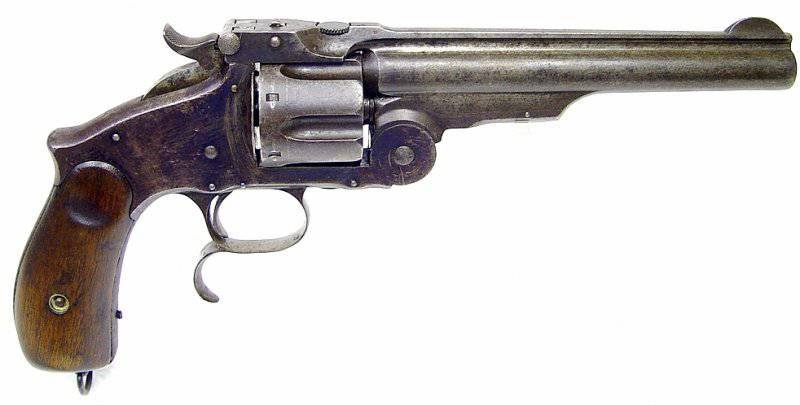
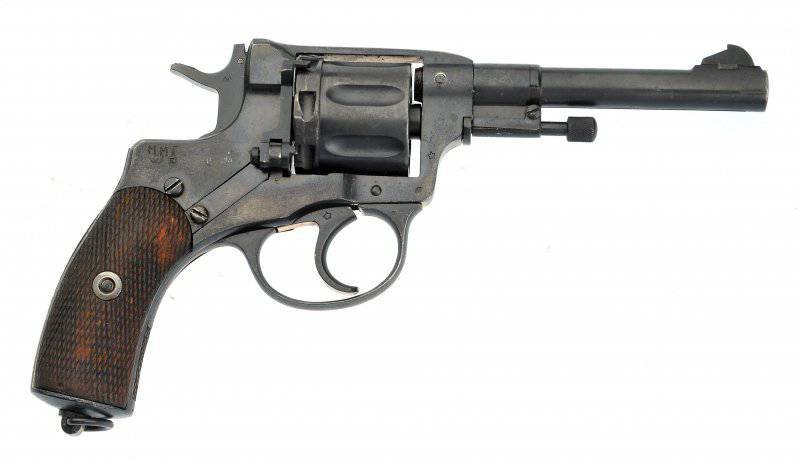
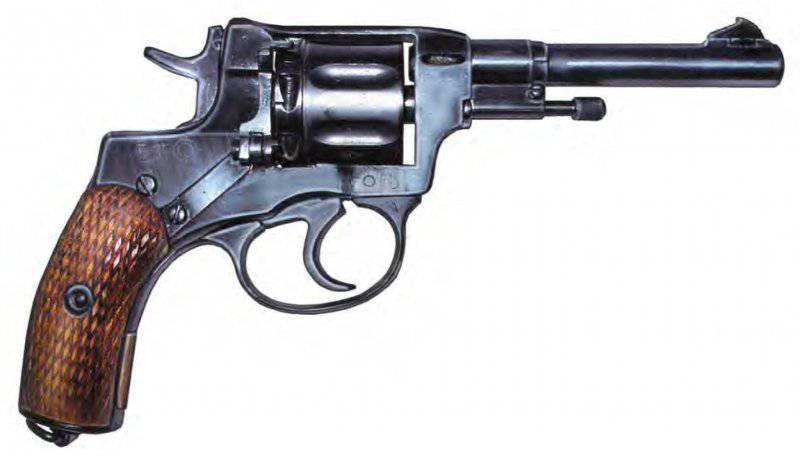
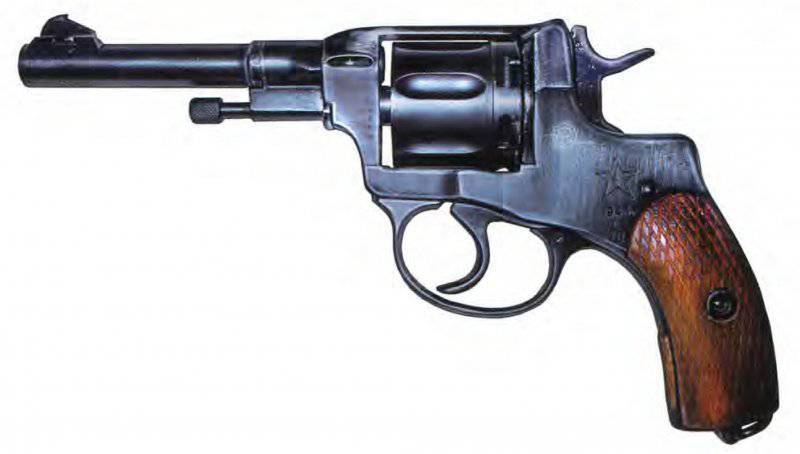
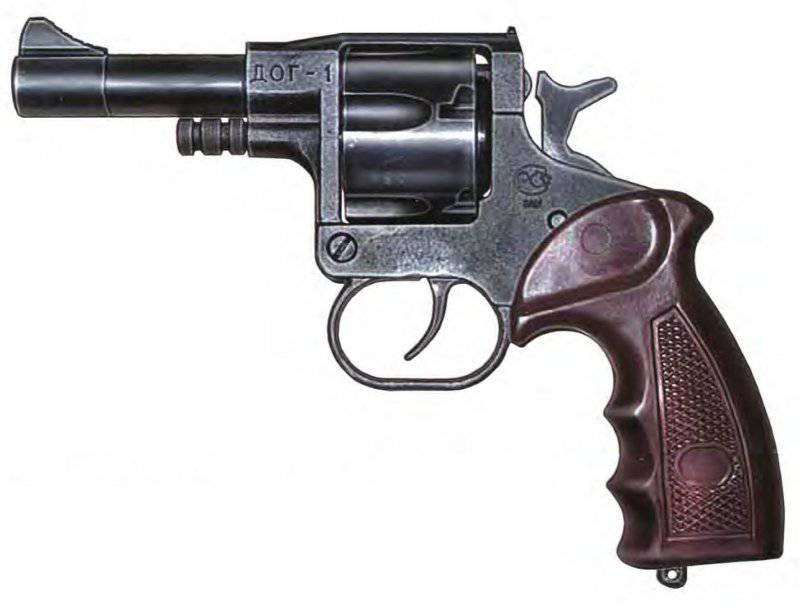
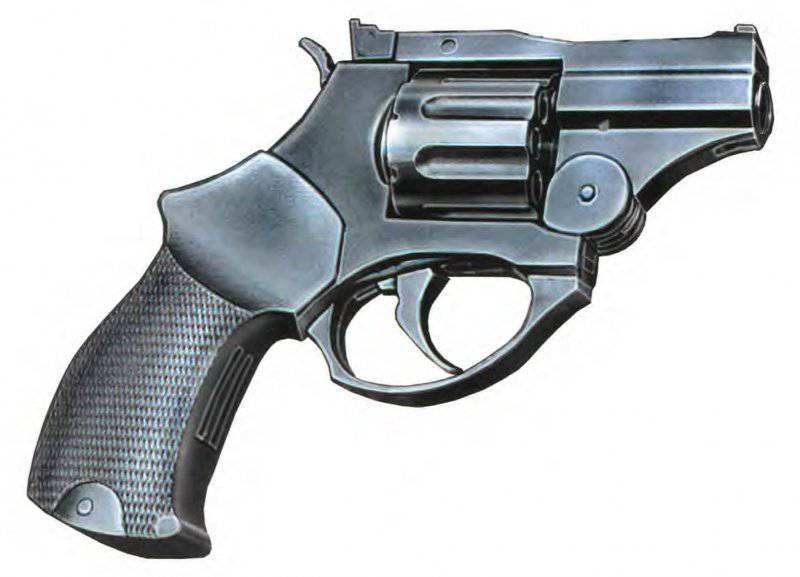
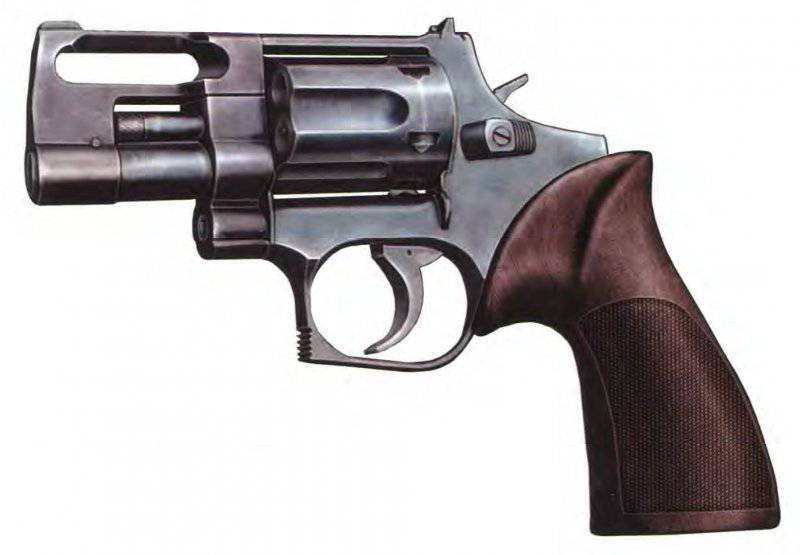
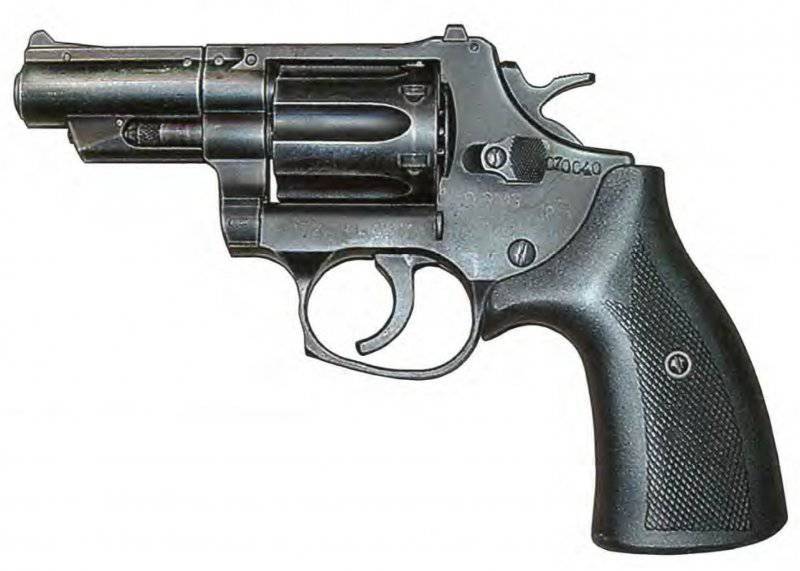
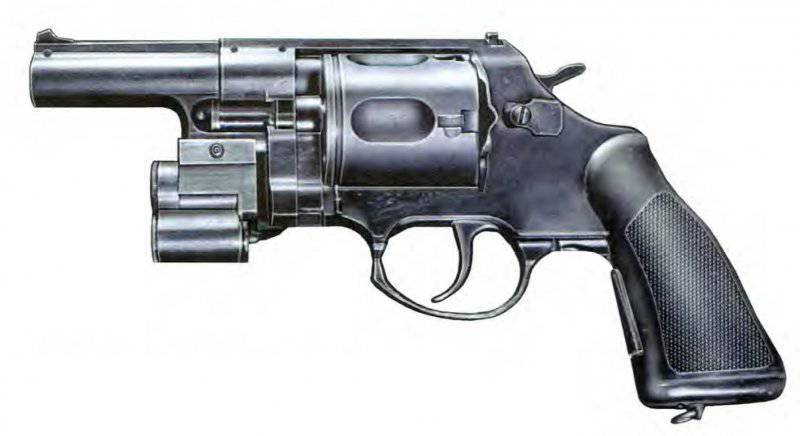
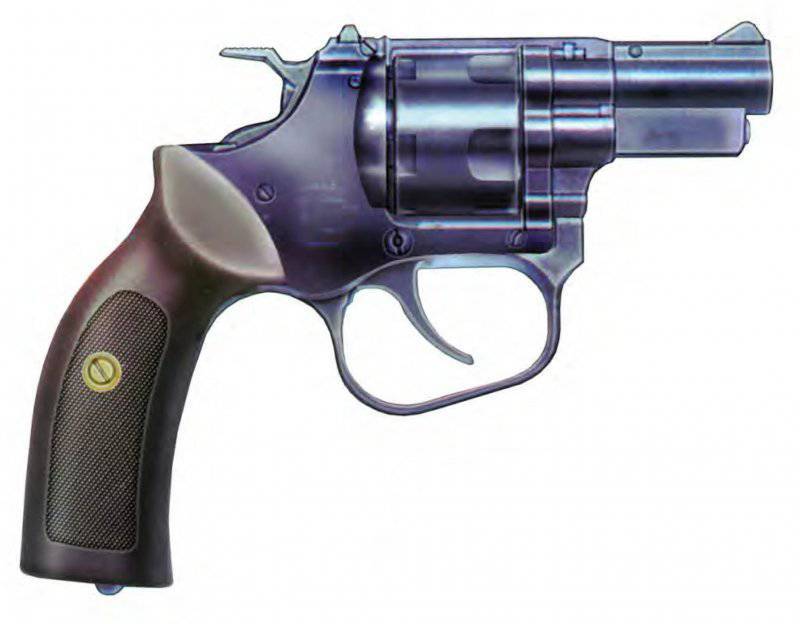
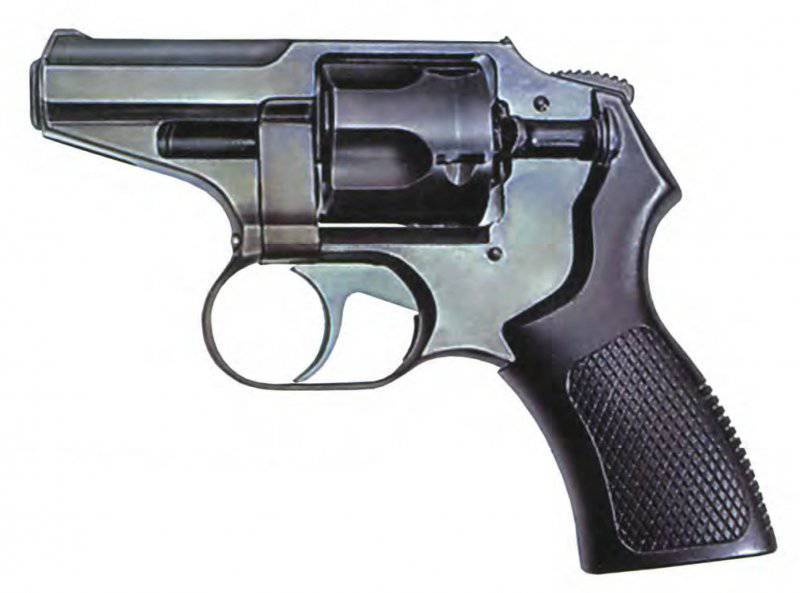
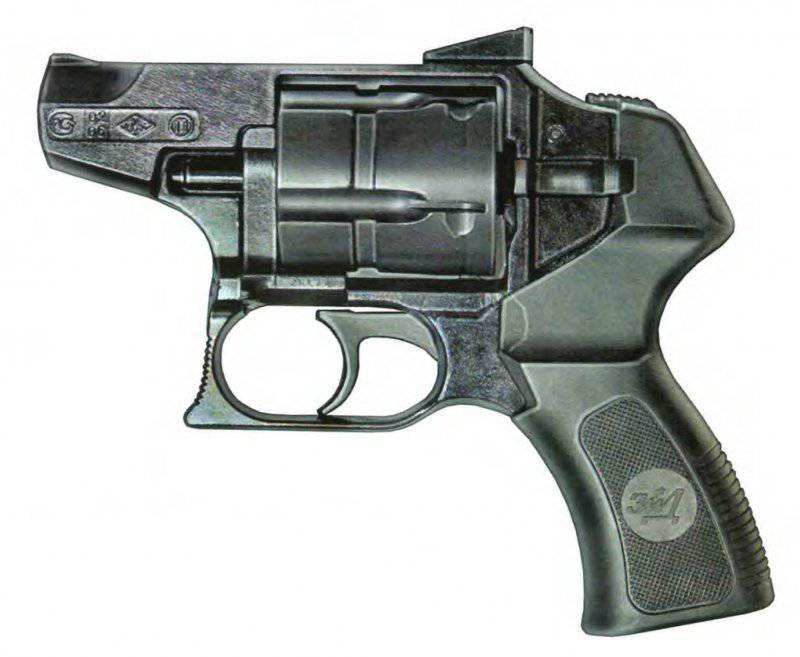
Information